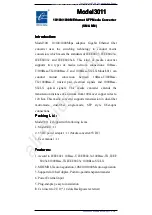
Decoder-Update-und-Sound-Loading devices MXULF, MXULFA Page 11
In case it is not possible to establish a direct connection from
one of the programs, the Device Manager has to be started.
There, in “Ports (COM & LPT)”, the installed MXULF (in this
case as “ZIMO interface”) and the number of the COM Port next
to it (COM3) is located. Enter this exact port in the desired pro-
gram!
In case the COM Port is higher than 16 and ZSP is used, right-
click “ZIMO interface” in the Device Manager, select “Proper-
ties” in the 2nd tab, then “Connection Settings”, button “Extend-
ed”; in the lower part of the window appearing select a port
number.
ZSP automatically locates the correct port (to which the
MXULF was allocated by Windows at installation of the driver).
ZSC provides the window “Settings” in “?”, where, either
suggested or in the drop-down menu, you select the COM Port
with the corresponding reference (“ZIMO Interface”, “MX31ZL”
or “MXULF”).
P.F.u.Sch. provides “Options” under “Parameter”, where
you can select the COM Port. Sometimes it is useful to
use the Windows Device Manager, where the installed
MXULF is located as “ZIMO interface”, “MX31ZL” or
“MXULF” - see below.
Windows Device Manager to find the installed MXULF:
Windows software to use MXULF(A), a selection
ZSP
(creation of sound projects, decoder updating, sound loading)
:
in the picture above you see the display during the software update of a sound decoder MX645;
MXULF is recognized as MX31ZL (because the MXULF behaves the same).
ZCS
(„ZIMO CV Setting“, by Matthias Manhart, http://www.beathis.ch/zcs/index.html)
:
Comfortable tool to configure the decoder with a number of tabs,
especially to modify sound projects, but also to adjust them in real time, i.e. the parameters
are effective directly during driving operation.





























